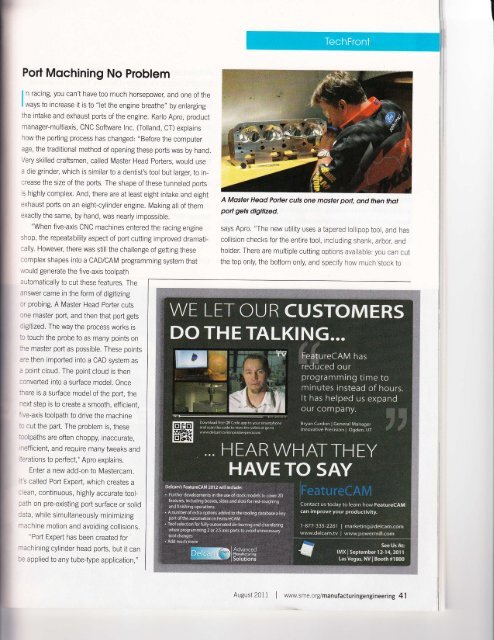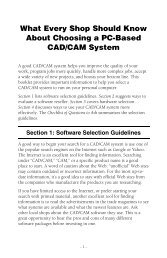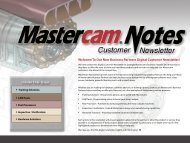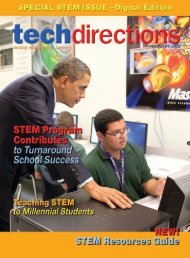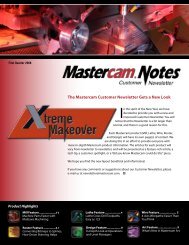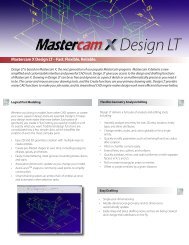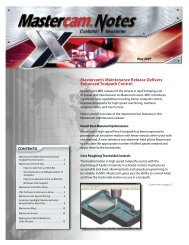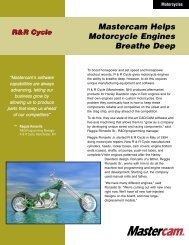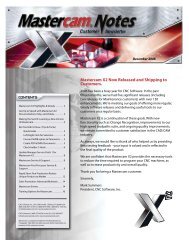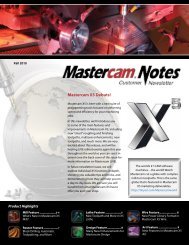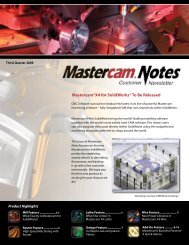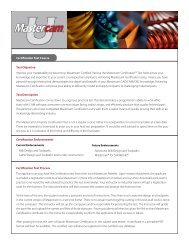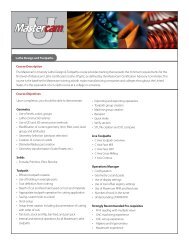Port Machining No Problem - Mastercam
Port Machining No Problem - Mastercam
Port Machining No Problem - Mastercam
You also want an ePaper? Increase the reach of your titles
YUMPU automatically turns print PDFs into web optimized ePapers that Google loves.
<strong>Port</strong> Mqchining <strong>No</strong> <strong>Problem</strong><br />
n racinS, you can't have too much horsepower, and one of<br />
I<br />
the<br />
I ways to increase it is to "let the engine breathe,, by enlarging<br />
the intake and exhaust ports of the engine. Karlo Apro, product<br />
manager-multiaxis, CNC Software lnc. (Tolland, CT) explains<br />
how the porting process has changed: "Before the computer<br />
age, the traditional method of opening these ports was by hand.<br />
Very skilled craftsmen, called Master Head porters, would use<br />
a die grinder, which is stmilar to a dentist's tool but larger, to in-<br />
crease the size of the ports. The shape of these tunneled porls<br />
is highly complex. And, there are at least eight intake and eight<br />
exhaust ports on an eight-cylinder engine. Making all of them<br />
exactly the same, by hand, was nearly impossible.<br />
"When five-axis CNC machines entered the racing engine<br />
shop, the repeatability aspect of port cutting improved dramati-<br />
:ally. However, there was still the challenge of getting these<br />
:omplex shapes jnto a CAD/CAM programming system that<br />
,vould generate the five-axis toolpath<br />
automatically to cut these features. The<br />
answer came in the form of digitizing<br />
cr probing. A lVaster Head <strong>Port</strong>er cuts<br />
cne master port, and then that port gets<br />
5igitized. The way the process works is<br />
-o touch the probe to as many points on<br />
:he master port as possible. These points<br />
are then imported into a CAD system as<br />
: point cloud. The point cloud is then<br />
:onverted into a surface model. Once<br />
:rere is a suface model of the port, the<br />
^ext step is to create a smooth, efficient,<br />
've-axis toolpath to drive the machine<br />
.c cut the part. The problem is, these<br />
.rolpaths are often choppy, inaccurate,<br />
refficient, and require many tweaks and<br />
-erations to perfect," Apro explains.<br />
Enter a new add-on to <strong>Mastercam</strong>.<br />
:s called <strong>Port</strong> Expert, which creates a<br />
: ean, continuous, highly accurate tool-<br />
:ath on pre-existing port surface or solid<br />
:ata, while simultaneously minimizing<br />
-achine motion and avoiding collisions.<br />
"<strong>Port</strong> Expert has been created for<br />
-achining cylinder head ports, but it can<br />
:e applied to any tube-type application,"<br />
A Moster Head Pofiet culs one moster port, and then that<br />
poil gets digitized.<br />
says Apro. "The new utility uses a tapered lollipop tool, and has<br />
collision checks for the entire tool, including shank, arbor, and<br />
holder. There are multiple cutting options available: you can cut<br />
the top only, the bottom only, and specify how much stock to<br />
August2011 | www.sme.org/manufacturingengineering 41
s.MIS MOTION WITH MINIMUM TiLT<br />
TAPERED OVERLAP<br />
*"i<br />
I<br />
SMOOTH, SPIRAL PATH<br />
Mqstercom's <strong>Port</strong> Expert odd-on creoles highly occurole five-<br />
oxis loolpoth on prc-existing poi surtoce or solid doto, simul-<br />
loneously minimizing mochine motion ond ovoiding collisions.<br />
leave on the entire port. The toolpaths use three-axis machinlng<br />
as far into the port as possible, and then convert automatically<br />
to five-axis motion with minimum tilt. This leaves no fishtails or<br />
inefficient reverse moves, and smoothly transitions where the<br />
toolpaths meet at the middle of the port. The add-on provides<br />
both roughing and finishing toolpaths to make ports from cast-<br />
ings or billets. Further, because <strong>Port</strong> Exped can support unlim-<br />
ited sudaces, the geometry can be made of multiple surfaces<br />
that are stitched together.<br />
"After programming the toolpaths, a programmer can<br />
simulate the cutting process without leaving his or her desk.<br />
<strong>Mastercam</strong> creates five-axis code that can run any CNC<br />
machine. The simulation proceeds step-by-step through the<br />
toolpath, even conveying the motion used in transition at the<br />
middle of the port. Simulation is a safe and cost-effective way of<br />
proving out the toolpath, and it can also aid in designing better<br />
fixtures. With <strong>Port</strong> Expert, not only are engines breathing easier,<br />
so are the machine programmers and Master Head <strong>Port</strong>ers,"<br />
Apro concludes.<br />
For more information from CNC Software email karlo.<br />
apro@mastercam.com "<br />
Look<br />
?SIB<br />
[.i


